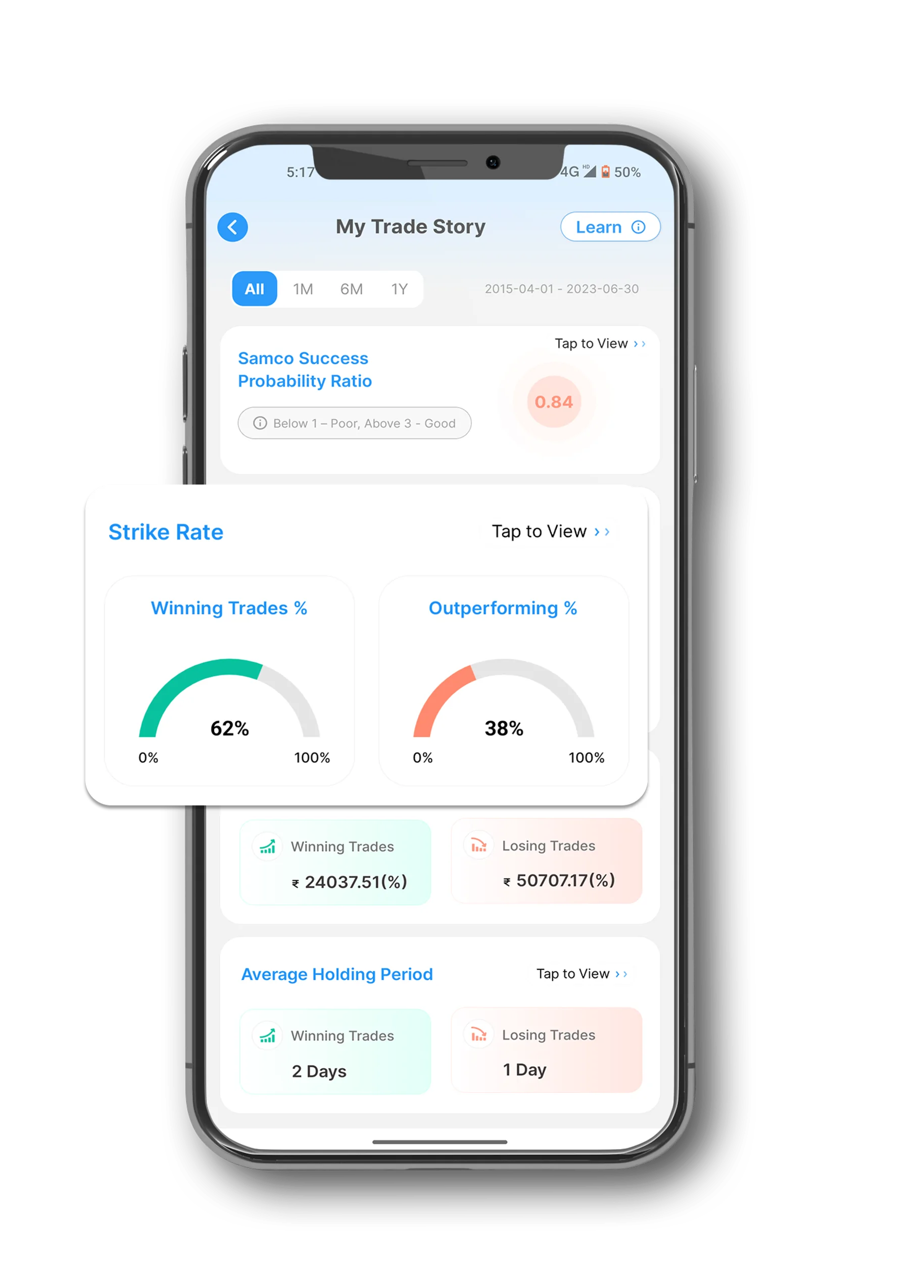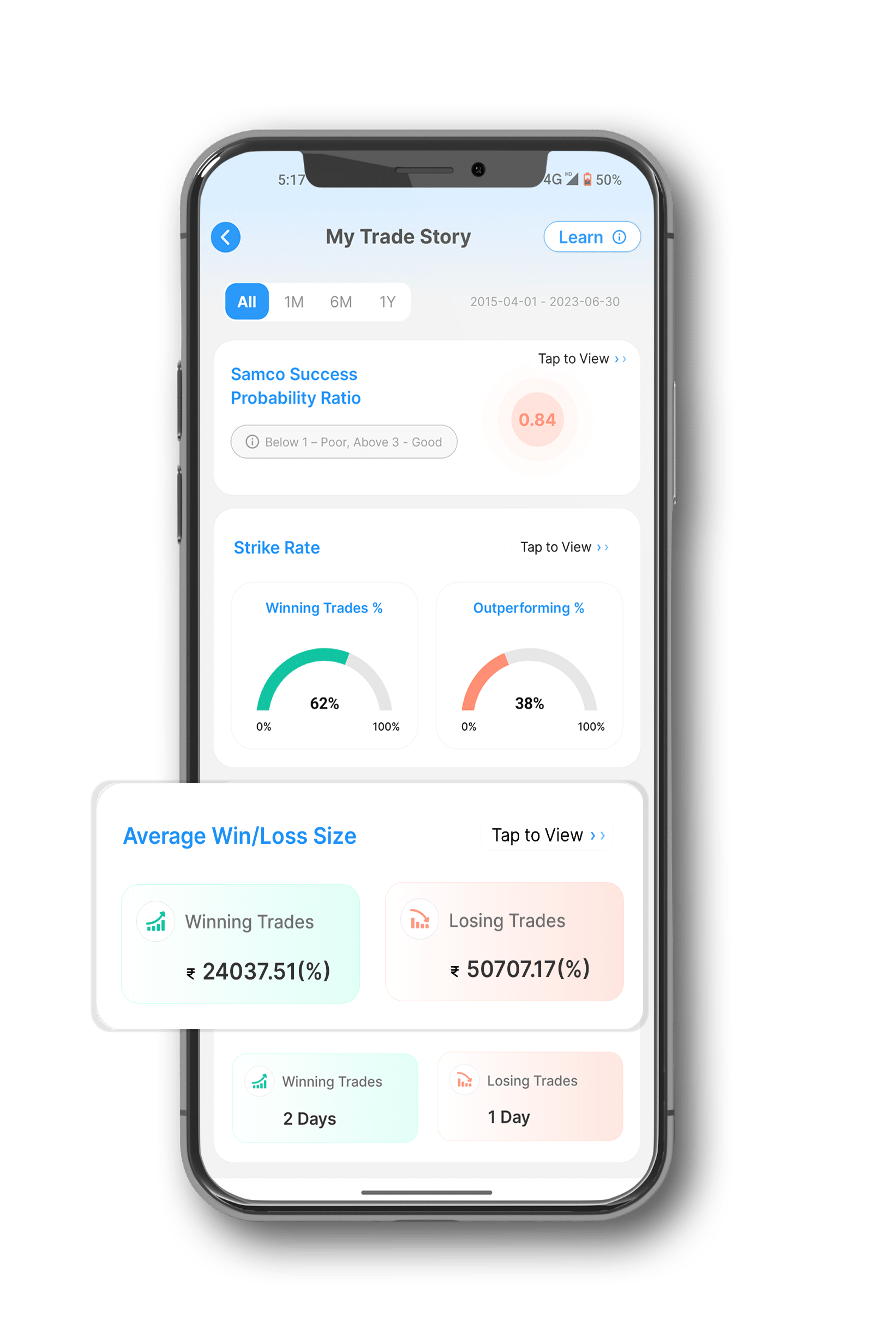Beyond Profit and Loss: Key Metrics to Measure Your Trading Success
Here’s a quick little quiz for you: How do you know if you are a good trader?
If you’re like most people, you may be looking at your profits and losses to check how successful you are.
For example, consider the following parameters about your trading performance in the derivatives market over the past two months.
- Losses: Rs. 2,00,000
- Profits: Rs. 3,00,000
- Net Position: Rs. 1,00,000 worth of profits
For all intents and purposes, this indicates that you are a good trader. However, focusing only on profit and loss is definitely not enough to truly measure your trading success. By looking at only these two aspects, you are discounting various other factors that are crucial to your online trading success.
Beyond Profit and Loss: Two Key Metrics to Gauge Your Trading Performance
Beyond the trading profit and loss, there are two underrated and often overlooked metrics that you need to evaluate to assess your overall trading performance. These are:
- Your risk-reward ratio
- Your strike rate
Let’s delve into these two underestimated metrics and see how they can offer you unseen insights into your trading performance.
-
Risk-Reward Ratio
The main goal of initiating any trade is to earn monetary gains. However, every open position in the stock market carries some degree of risk. Comparing these two aspects, we get the risk-reward ratio, which is the ratio of the potential loss and the potential gain from a trade.
Risk-reward ratio analysis helps you understand if the risk you are taking on for a trading position is worth the rewards you earn from it. Or, in other words, you can check if the rewards earned justify the risks taken. Ideally, a lower risk-reward ratio is preferable because it indicates that the returns you earn for every unit of risk taken may be higher.
Market experts often consider a risk-reward ratio of 1:3 to be ideal. This means the returns you can earn are three times the risk your portfolio is exposed to. However, in practical trading scenarios, it can be challenging to find this sweet spot between risk and returns. In most cases, the risks may far outweigh the potential returns.
Here’s where hedging can help. You can offset a trade that has a high risk-reward ratio with a trade that has a lower risk-reward ratio — thereby bringing down the overall risk. You can also use stop-loss orders to limit the risk. Theoretically, this seems easy. However, when you are in the midst of active trading, it can be quite difficult to quantify the risks for each trade and determine how much of a potential loss you need to hedge.
-
Strike Rate

The strike rate is another important metric that most traders overlook. It tells you how successful you are as a trader. In simple terms, your strike rate is the percentage of your winning trades.
So, for example, let’s say you’re into intraday trading. If you make 100 trades during a month, of which 45 are profitable, you have a winning strike rate of 45%. The strike rate can also be calculated for your losing trades. In the above example, your losing strike rate will be 55%.
Broadly, a higher strike rate indicates that you have the ability to consistently identify profitable positions and trades in the stock market. Many traders overlook this metric when evaluating their overall trading performance. Merely having a net profitable situation at the end of the month is not an indicator of successful trading.
For instance, you may have suffered losses on 90% of your trades. However, if your profitable trades have resulted in significant returns, you may be able to offset the losses temporarily. This does not negate the fact that most of your trades were loss-making.
Computing the Risk-Reward Ratio and Strike Rate
Any trader who is good at basic mathematics and knows the formula for computing the risk-reward ratio and the strike rate can easily calculate these metrics for each trade. Then, why is it that most traders fail to do so? The answer is two-fold.
Firstly, many traders are not aware of these parameters. They continue to focus solely on the profits and losses to check if their trading strategy is working. Secondly, even among traders who are aware of the importance of these metrics, there is a noticeable lack of tools that can help conduct such real-time analysis. The few options available in the stock market are too expensive for the average retail trader. The alternative of relying on good old spreadsheets always remains, but it can be extremely time-consuming for active traders who need to focus on the market and strategize their trades in real-time.
Here’s where Samco can help.
Analyse Your Trading Performance with the New-Gen App from Samco Securities
To make it easier for traders like you to understand your performance and assess your growth trajectory, Samco Securities has rolled out an all-inclusive trading app that offers various insights into your risk-reward ratio, strike rate, average profit/loss size and more! Here is a closer look at some of the key unseen insights that our app offers:
-
Strike Rate:

On Samco’s trading app, you can check the winning and losing strike rate for every trading strategy you implement and for each sector you trade in. What’s more, you can also track the strike rates for your trades based on the market caps of the securities you buy and sell. This can be crucial for understanding various parts of your trade story, such as:
- Which strategies are successful and which aren’t
- Which segments of the share market are most profitable for you
- Which market cap segment has given you more successful trades
For instance, say your winning strike rate is 75% in the derivatives market but only 55% in the cash segment. This is a clear indicator that you need to focus on the futures and options market more because your trading performance is better in that segment.
-
Average Win and Loss Sizes:

The Samco trading app also gives you underrated and unseen insights about your average win and loss sizes. The average win size is the average profit generated per trade, while the average loss size is the average loss incurred per trade. Like the strike rate, the average profit/loss size is also available at a strategic, sectoral and market cap level.
It’s important to understand this because it tells you whether or not your current trading strategies are effective. For instance, say your average profit and loss sizes for different options trading strategies in the equity options segment are as follows:
| Strategy | Average Win Size | Average Loss Size |
| Short call | Rs. 15,000 (45%) | Rs. 2,500 (20%) |
| Long put | Rs. 28,000 (60%) | Rs. 4,500 (12%) |
|
Short put |
Rs. 2,000 (5%) | Rs. 42,000 (82%) |
With these insights, you can figure out that the short call and long put strategies have been successful for you, but the short put strategy, which has a larger average loss size, hasn’t been as rewarding. You can then use this information to modify your options trading strategies as required.
Redefine Trading Success With Samco
Understanding the underrated yet crucial metrics discussed above is only the first step in your journey to becoming a successful trader. To improve the outcomes of your trades consistently, you need to track these metrics on a regular basis and make material changes to the strategies you use or the segments you trade in.
For an individual retail trader, this may seem nearly impossible due to the costs involved, the resources required and the sheer time-consuming nature of such extensive analysis. The good news is that Samco Securities makes this possible for every retail trader.
Here’s why our new-gen trading app can redefine trading success for you.
- You get comprehensive insights into your trade story free of cost.
- You get actionable suggestions about how you can improve your trading performance.
- You can monitor your progress via the Samco trade score.
If you already have a trading account, switching to Samco is easy. Once you complete the simple online account opening process, you can download the new-gen Samco trading app, log into your account and access the scores of exclusive features we offer.
